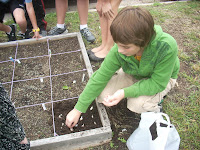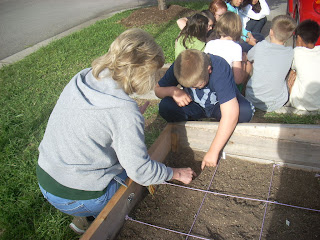Over the last few weeks we've done a lot of cooking with the harvests of the fall garden. Here, Morgan and Montana enjoy Roasted Turnip Salad; the turnips were a gift from Mr. Nolen, our PE teacher. We used our Oriental greens, Italian cress, and lettuce. With the turnips we also made Crispy Turnip Fries and Braised Turnips (AKA: Turnips with Bacon).
Next we used the cress in Garden Corn Bread, and added more of our greens to make our favorite Mixed Green Salad. The dressing is the best! We used fresh garlic from last year's garden.
We also enjoyed Pickled Radishes with our salad, and last Friday we enjoyed Chinese Mustard Green Soup on a cold day.
Monday, November 7, 2011
November Harvests
After nights of freezing temperatures, we checked last Monday to see how the plants survived. The gardens have grown abundantly with the warm fall days and plentiful rain, and we have just begun to harvest them regularly.
If you look closely, you can see the melting frost on the leaves...
Everything looked even better than the week before! Obviously, these plants love cold, fall days and nights.
Sarah made a final harvest of her Easter Egg radishes.
If you look closely, you can see the melting frost on the leaves...
Everything looked even better than the week before! Obviously, these plants love cold, fall days and nights.
Sarah made a final harvest of her Easter Egg radishes.
Monday, October 31, 2011
Weeding and Watering: October 5 and 6, 2011
The Italian cress was the first plant to grow large:
We spent a warm afternoon pulling weeds from our new seedlings:
Then it was time to water the plants:
We spent a warm afternoon pulling weeds from our new seedlings:
Then it was time to water the plants:
Monday, September 26, 2011
Thinning the Seedlings
Today we were happy to see sprouts in almost every garden square. The rainy weather has been good for our gardens. Unfortunately, when you plant 2 seeds in one hole and both of them grow, only one can stay...
Wednesday, September 21, 2011
Gardening in Rainy Weather
Today we used the rainy weather to finish up some last-minute planting and add some fertilizer to our well-used soil. We are already seeing tiny plants popping through, even though they've been in the ground less than a week!
Reuben dug out several inches of soil and placed garlic cloves in his square before covering them up again. He's agreed to patiently wait for the June garden harvest, knowing the rewards might be enjoyable! (He'll get to eat our garden food again next semester, unlike everyone else.)
Meanwhile, everyone else sprinkled their squares with two kinds of fertilizer. We added a little organic blood meal for instant nitrogen to get our plants started, and we also added a small amount of slow-release fertilizer to be there as they grow. The rain should wash the fertilizer into the soil, so we hope this is perfect timing.
Reuben dug out several inches of soil and placed garlic cloves in his square before covering them up again. He's agreed to patiently wait for the June garden harvest, knowing the rewards might be enjoyable! (He'll get to eat our garden food again next semester, unlike everyone else.)
Meanwhile, everyone else sprinkled their squares with two kinds of fertilizer. We added a little organic blood meal for instant nitrogen to get our plants started, and we also added a small amount of slow-release fertilizer to be there as they grow. The rain should wash the fertilizer into the soil, so we hope this is perfect timing.
Friday, September 16, 2011
Fall Planting: September
Today we finished planting 4 Brussels sprouts seedlings, and the following seeds:
- onions
- radishes
- red cabbage
- Swiss chard
- kohlrabi
- lettuce (lots of kinds!)
- cauliflower
- bok choy
- carrots
- Asian greens
- cress
- spinach
- mustard greens
- beets
Uncovering the Gardens: August 2011
On August 29th we opened the gardens to see how they faired under the black plastic during the hot summer months.
The bad news was that the weeds somehow found the tiniest spaces in which to grow.
The really good news is that some gardens were free from all weeds AND wire grass! That's a big improvement from previous years.
This rhinoceros beetle didn't survive the heat. Read more about it below:
The bad news was that the weeds somehow found the tiniest spaces in which to grow.
The really good news is that some gardens were free from all weeds AND wire grass! That's a big improvement from previous years.
This rhinoceros beetle didn't survive the heat. Read more about it below:
Grants' Rhinoceros Beetle
(Dynastes granti)
by Jon Fouskaris & Orin McMonigle
(Dynastes granti)
by Jon Fouskaris & Orin McMonigle
ADULT MALES Specimen provided by US Insects. Photo taken by US Insects. | Grants' Rhinoceros Beetle is the longest of the US rhinoceros beetles with the record specimen at 85mm (3.25 inches)! It is a very impressive beetle with a heavy build. Females resemble monstrous spotted June beetles while the males look much more exotic and possess a horn on both the pronotum and head. The horns of the male are used in fighting over females and food. Smaller males can have very tiny horns although properly feeding larvae will produce all major males, like the captive-bred males pictured to the left. In the wild, Grants' Rhinoceros Beetles can be found out at night feeding on tree sap. In captivity, maintaining these beetles is much easier. Unlike many other invertebrates, Grants' Rhinoceros Beetles don't seem to get stressed out by being handled and gently played with by people. They also do not pose a threat to humans when bites and stings are concerned, therefore, these giant beetles make excellent pets! The Grants' Rhinoceros Beetle only lives for one or two years, but it's still an invertebrate worth keeping. They have been becoming more popular lately, and it is easy to see why. The Grants' Rhinoceros Beetle is a perfect combination of simple care, good temperament, and large size. |
Thursday, June 9, 2011
Finishing the Greenhouse in the HEAT!
Cooking for Ms. Fajardo's Green Math Class
 As a big thank-you to the students of Green Math (they built our 4th critter cage, 2 cold frames, and THE GREENHOUSE!) we cooked Swiss chard cornbread and beets and carrots salad, all grown in the the cold frames they built for us.
As a big thank-you to the students of Green Math (they built our 4th critter cage, 2 cold frames, and THE GREENHOUSE!) we cooked Swiss chard cornbread and beets and carrots salad, all grown in the the cold frames they built for us.
 Ms. Fajardo even tasted beets, and she doesn't even like vegetables (yet...).
Ms. Fajardo even tasted beets, and she doesn't even like vegetables (yet...).
Wednesday, May 25, 2011
Subscribe to:
Posts (Atom)

























































